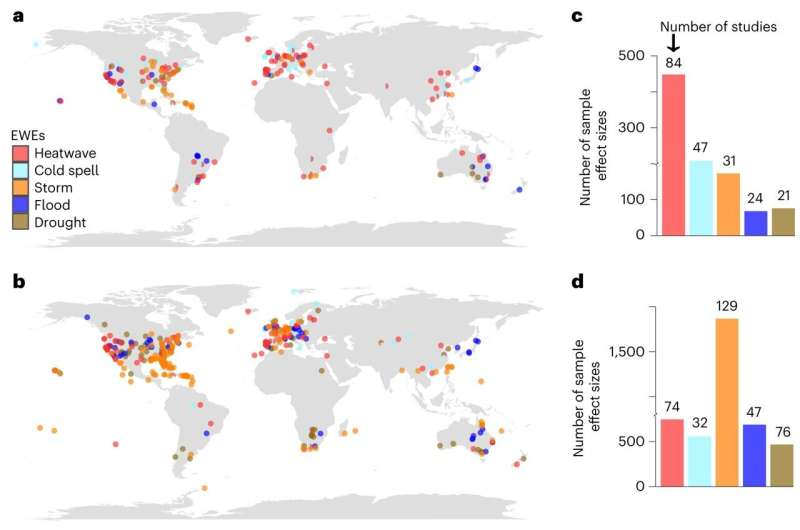This article has been reviewed according to Science X's editorial process and policies. Editors have highlighted the following attributes while ensuring the content's credibility:
fact-checked
peer-reviewed publication
trusted source
written by researcher(s)
proofread
Extreme weather may help invasive species outcompete native animals, new study finds

Non-native species appear to be better able to resist extreme weather, threatening native plants and animals and potentially creating more favorable conditions for invasive species under climate change. That's the conclusion of a new study in the journal Nature Ecology and Evolution.
Wildfires, droughts, heavy rainfall, and storms are all increasing and predicted to become more frequent throughout the next century due to human-driven climate change.
At the same time, humans are transporting more species into new areas, despite concerted global efforts to increase biosecurity across borders and to target the eradication of specific species. Some of these non-native species can go on to become invasive, damaging native ecosystems.
Capitalizing on opportunities
Invasive species introduced by humans often possess traits that help them survive or even thrive when ecosystems are disturbed (perhaps by wildfire, a storm or human buildings).
Invasive plants are generally fast-growing, for instance, allowing them to fill gaps before native species can recover from disturbances quickly. They are also often very good at dispersing their seeds, allowing them to colonize disturbed areas quickly.
This is why scientists have long suspected that extreme weather and the success of non-native species could be linked.
If extreme weather removes native plants and animals, that increases the availability of resources such as water and space. Non-native species can then capitalize on these new resources to establish themselves.
Even more concerning is the potential for extreme weather and non-native species to interact, exacerbating their effect on native biodiversity. For instance, in a recent field experiment in the US, scientists deliberately started a fire that killed about 10% of the longleaf pine trees in the area studied.
But in areas where an invasive grass—cogongrass, an Asian native—was allowed to establish itself alongside the pines, the fires had more fuel and were larger, hotter, and burned for longer.
Where the scientists had added rain shelters to simulate drought conditions, the grass dried out further and the fires became much more lethal. A combination of drought and the invasive species meant longleaf pine mortality soared to 44%.
Similarly, on the small Macquarie Island in the southwest Pacific, a combination of extreme rainfall and the presence of invasive European rabbits reduced the breeding success of nesting black-browed albatrosses. Heavy grazing by the invasive rabbits reduced plant cover, exposing the albatross chicks to the harsh weather conditions.
This relationship between extreme weather and invasive species—two human-driven drivers of global change—threatens native plants and animals and could cost countries billions of dollars in coming decades. Ecologists must identify priority areas and species that can be targeted in efforts to minimize costs and prevent the loss of native biodiversity.
Bad weather, good for non-natives
To better understand how native and non-native species respond to extreme weather events, the scientists behind the new study reanalyzed information from 443 peer-reviewed studies on how species responded to wildfires, droughts, and storms. In all, they gathered data on 187 non-native species and 1,852 native species from all major animal groups.
Their results suggest that native and non-native species may indeed respond differently to extreme weather. Across all studies, a total of 24.8% of non-native species benefited from extreme weather events compared to only 12.7% of native species.
For example, while droughts harmed native species in freshwater and land-based ecosystems, their non-native counterparts showed no significant response. Notably, marine ecosystems were comparatively more resistant to extreme weather events, with fewer differences between native and non-native species.
The authors did find marine heat waves harmed native coral species, however, a relationship that has been documented in other scientific studies.
Identifying global hotspots
The authors took this information and combined it with known global hotspots of extreme weather, to identify areas where native species may be particularly vulnerable to the combination of extreme weather and invasive species.
They found high latitude areas such as northern US and Europe, for instance, are both vulnerable to extreme cold spells and possess non-native species that benefit from cold spells. Alternatively, areas of the western Amazon in Brazil and east Asia were identified as vulnerable to flooding and possessing flood-resistant non-native species.
In these regions, non-native species could benefit from increasing cold spells or flooding respectively, posing a greater threat to native plants and animals.
Studies like this are very useful. Regions that are identified as vulnerable can be targeted with early preventative measures to stop the spread of invasive species, or with measures to help native biodiversity cope with climate change.
This research could also allow targeted restoration to remove non-native species and produce invasion-resistant native communities that could better withstand future conditions. This is what happened on Macquarie Island, where invasive rabbits and rats were eventually eliminated and the whole ecosystem soon bounced back.
Such action could be critical as we adapt to a changing climate and a greater mixing of the world's plants and animals.
More information: Shimin Gu et al, Meta-analysis reveals less sensitivity of non-native animals than natives to extreme weather worldwide, Nature Ecology & Evolution (2023). DOI: 10.1038/s41559-023-02235-1
Journal information: Nature Ecology & Evolution
Provided by The Conversation
This article is republished from The Conversation under a Creative Commons license. Read the original article.![]()




















